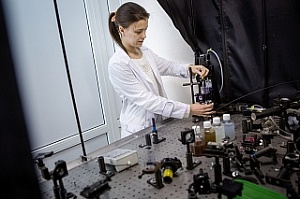Scientists of Tomsk State University SPhTI optimized the synthesis technology of unique nanoparticles using pulsed laser ablation in liquids, which makes it possible to receive hundreds of liters of colloidal solutions of nanoparticles or dozens of grams of different nanopowders in a month. Up to now no one in the world has managed to achieve such productivity. This achievement will allow Russian researchers greater use of such nanomaterials in practice and receive significant scientific results in biology, medicine, chemistry, and other areas.
Laser ablation in a liquid is the method allows obtaining nanosized particles in the solution without the addition of impurities and without wastes, so-called pure nanocolloids. For the first time the method was applied in 1993 and now it is widely used for the synthesis of nanoparticles in basic research. But because of low productivity, it was not considered by experts for practical purposes. Scientific studies of the Laboratory of New Materials and Advanced Technologies of SPhTI allowed to significantly increasing the productivity.
The method itself consists of a target that is placed in a fluid and irradiated with focused laser pulses. The result is a rapid heating and explosive evaporation of target material from the surface in the form of ionized plasma. This process is called laser ablation. During cooling of plasma nanoparticles in the form of the colloidal solution are formed in liquid.
- In the course of research, we have established a number of regularities between the thermophysical properties of target materials, solvents, optical properties of nanoparticles, and features of the ablation process thanks to which high efficiency of synthesis is achieved for a long time, - said Valery Svetlichniy, deputy head of the Laboratory of New Materials and Advanced Technologies.
Test samples of nanoparticles are used for research in physics, chemistry, biology, and medicine, for example for the study of their toxicity and environmental impact, using as antiseptics, bio-stimulants, and others. In particular, by using of nanoparticles of precious and heavy metals, which are produced in the laboratory, TSU biologists simulate their dissemination from soil and water in the food chains of different organisms. This allows scientists to develop environmental biotechnology clean environment from nano impurities.

